Peru has everything you can ask for: mountains, deserts, forests, seas, and a unique built heritage. In this post, we are going to share our two-week Peru itinerary.
In 2019, we embarked on an unforgettable journey to Peru, marking a memorable Christmas spent amidst the breathtaking beauty of the Pacaya Samiria reserve in the Peruvian Amazon Rainforest. Immersed in nature and disconnected from the modern world, it was an experience like no other. If you want to know more about it, read our blog post “Peruvian Amazon Rainforest Tour”.
Affiliate disclosure: This article contains affiliate links. If you choose to make a purchase through them, we may earn a small commission at no additional cost to you. These commissions help us continue creating helpful travel guides, tips, and inspiration. Thank you for your support!
A Visit to the Capital City Lima
After our Amazon adventure, we spent three days in Lima. This vibrant city on Peru’s desert coast blends history, culture, and incredible food. Its historic plazas, colonial churches, and stunning Pacific views make it a must-visit on any two-week Peru itinerary.
Lima is also a global food capital, famous for ceviche, lomo saltado, and causa rellena. The best time to visit is during summer (December–April) when temperatures range from 21°C to 30°C. This season is perfect for exploring parks, relaxing on the beach, and catching breathtaking Pacific sunsets.
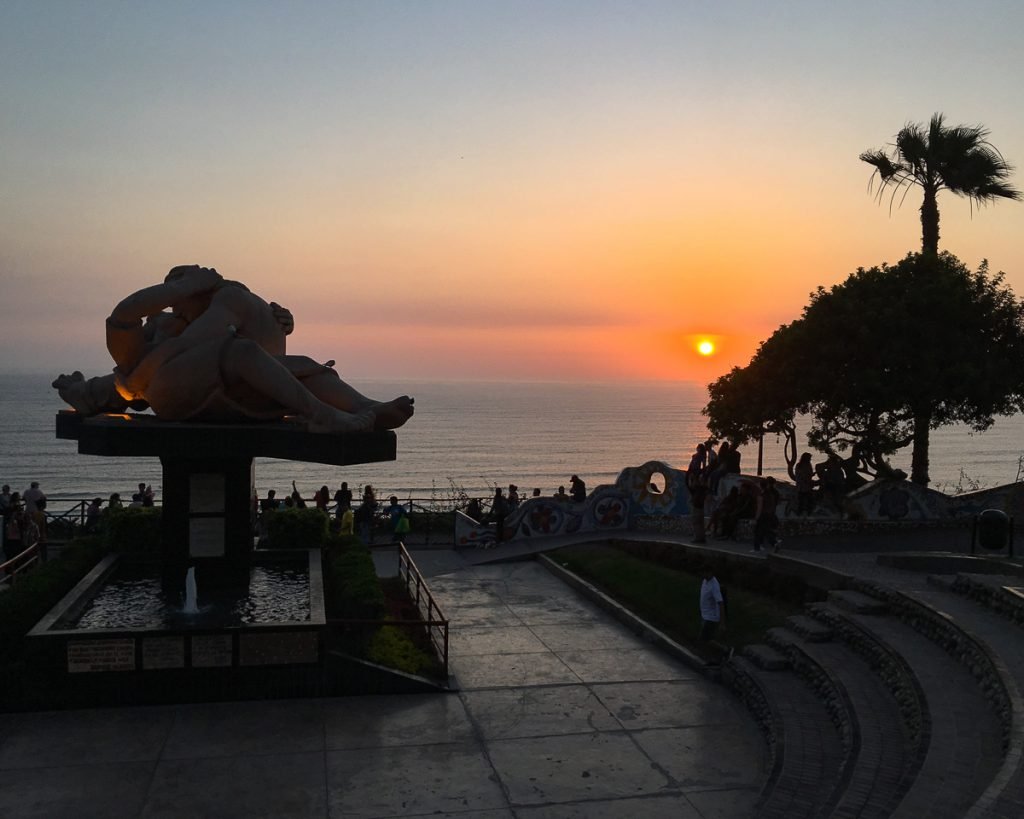
The Best Things to do in Lima
1. Free Walking Tour
As always, we opted for a free walking tour to explore the city. The Lima Free Walking Tour is a fantastic two-hour immersion into the historic center. It takes you through San Martín Square, where you can admire Lima’s stunning architecture, and past its most iconic landmarks, including the Government Palace and Cathedral of Lima. It’s an engaging way to learn about the city’s history while soaking in its lively atmosphere. Highly recommended!
2. Miraflores & Barranco Tour
Miraflores and Barranco are Lima’s most famous neighborhoods, and they’re well worth a visit. For a fun and unique way to explore them, try the Miraflores & Barranco E-Scooter Tour. Cruising through the city on an e-scooter adds a fresh twist to sightseeing. What better way to visit the romantic Parque del Amor in Miraflores or admire Barranco’s vibrant street art? It’s a great mix of culture, scenery, and adventure!
3. Santo Domingo Convent + Bodega y Quadra Museum
Lima is home to some of Peru’s best-preserved archaeological sites and historic landmarks. Leaving without exploring its rich history—from pre-Hispanic times to the 16th–19th centuries—would be a missed opportunity. A historic Lima tour is the perfect way to dive into the city’s past. This unique experience takes you to key sites like the Huaca Pucllana archaeological site, the Bodega y Quadra Museum, and the Santo Domingo Convent.
4. Lima Food Tour
Lima is one of the world’s top food capitals, and with the rise of contemporary and fusion cuisine, food tours are more popular than ever. A Lima Food Tour is the perfect way to dive into Peruvian gastronomy. You’ll learn about the country’s rich culinary traditions while tasting iconic dishes like papa a la huancaína and sipping classic drinks such as chicha morada and pisco sour. It’s a must for any foodie visiting Lima!
5. Magic Water Fountain
Few people know that Parque de la Reserva is home to the world’s largest fountain complex. The Magic Water Fountain and Dinner Show is one of Lima’s top nightlife attractions. The evening begins with a mesmerizing fountain show, where thirteen ornamental fountains project lights and images onto the water, all set to Peruvian music. After the show, you’ll enjoy a buffet dinner while watching a captivating traditional Peruvian dance performance.
TRAVEL ADVICE
With so much to see and do in Peru, planning every detail in advance can feel overwhelming. That’s why it’s smart to leave some room in your itinerary—and book activities on the go with a local Peruvian eSIM. Stay connected, flexible, and ready for whatever adventure comes your way.
Where to Stay in Lima
1. Miraflores
Miraflores is a must-visit district and one of the best places to stay in Lima. Known for its modern international shops, lively cafes, bars, and restaurants, it offers both convenience and charm. We stayed at Miraflores Apartments and really liked it. The location was safe and close to all amenities, making it the perfect base for exploring the city.
Discover the best places to stay in Miraflores
2. Barranco
Barranco is Lima’s bohemian heart, known for its quirky street art and stunning ocean views. It’s the perfect spot for craft beer, delicious food, art galleries, and artisanal boutiques. By day, it’s a charming, artsy neighborhood, but at night, it transforms. Plazas come alive with buskers, dancers, and circus performers, creating a vibrant and energetic atmosphere. If you’re looking for culture, nightlife, and a unique local vibe, Barranco is the place to be.
Discover the best places to stay in Barranco
3. San Isidro
San Isidro is Lima’s upscale district, known as the city’s financial hub and home to high-end shops and restaurants. It offers a more sophisticated vibe, perfect for those looking to experience Lima’s modern side. A highlight of the area is El Olivar, a serene olive tree forest in the heart of San Isidro. A stroll through this peaceful green space is a must while exploring the district.
Discover the best places to stay in San Isidro
Visiting the White City Arequipa
After Lima, we took an overnight bus to Arequipa. The journey was quite exhausting, lasting about 16 hours, but traveling overnight saved us a day.
Bus travel is popular in Peru because it’s affordable and covers most destinations. We often chose Cruz del Sur, a major bus operator known for its extensive routes and comfortable service. It’s a reliable option for getting around the country!
TIP: Overnight bus travel saves on hotel costs and maximizes your time for daytime activities! 😉
Arequipa is Peru’s second-largest city and a significant cultural capital. With its distinctive colonial architecture, it’s a must-visit on your two-week Peru itinerary. We started with a free walking tour, which provided a great overview of the “White City,” including San Francisco Church, the Order of Friars Minor Temple, and the San Lazaro neighborhood.
Next, we explored the Santa Catalina Monastery, which was hidden from the public for years until it opened in the 20th century. This monastery is part of the UNESCO World Heritage Site “Historical Centre of the City of Arequipa.” It’s truly not to be missed!

In Arequipa, we stayed at Casona de Sillar, and we really liked it. The location is perfect, right in the city center and close to all amenities. The staff was incredibly welcoming and even arranged a transfer to the bus station for us. It made our stay more convenient and enjoyable!
Discover the best places to stay in Arequipa
Discover the best things to do in Arequipa
Two-Week Peru Itinerary: Exploring the Colca Canyon
While in Arequipa, we embarked on a two-day trek in the Colca Canyon. This stunning canyon, located in the colorful Colca Valley, is home to pre-Inca inhabitants and towns founded during the Spanish colonial era. As one of the deepest canyons in the world, Colca Canyon is a must-see and should definitely be included in your two-week Peru itinerary!
Colca Canyon Trekking
Our first stop was Cruz del Condor, a breathtaking viewpoint where you can watch Andean condors soaring over the canyon. The views are incredible, and if you’re lucky, you might see these majestic birds up close.
Spending the night deep in the canyon was a highlight, offering a rare chance to disconnect and admire a sky filled with stars. However, the next day’s ascent was tough—steep inclines made it a real challenge. Some trekkers chose to ride mules, but we pushed through, keeping our packs light, carrying snacks, and taking frequent breaks.
The Colca Canyon Trek was one of the most rewarding experiences of our trip. Though we loved it, the trek was physically demanding, with long walks on uneven paths. If you’re looking for an easier alternative, consider the Colca Canyon 2-day trip or the Colca Valley Tour.
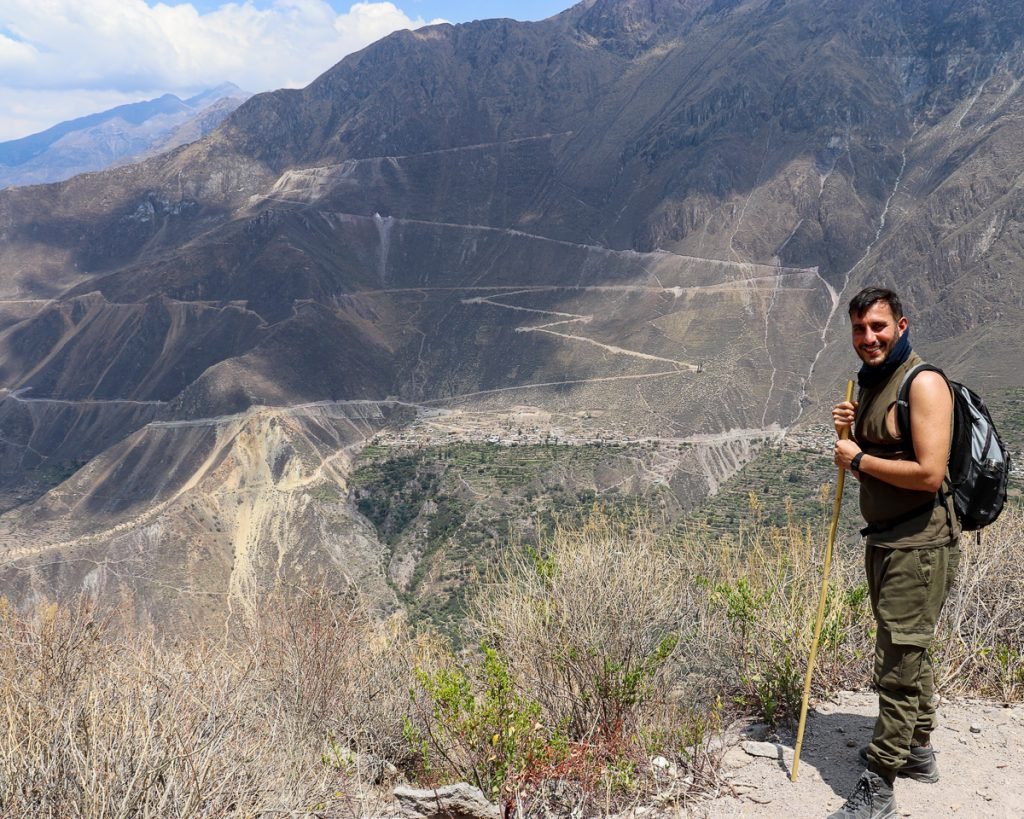
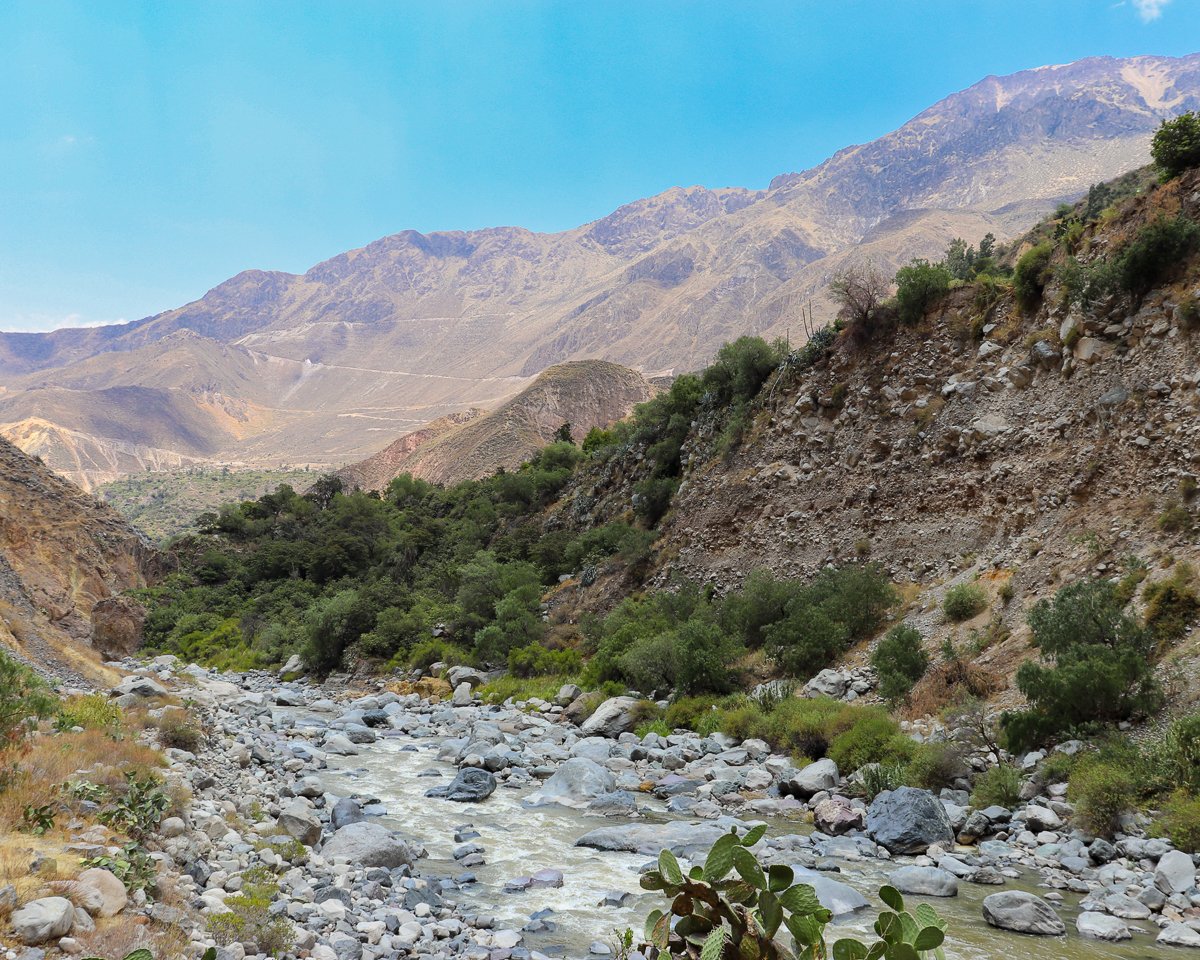
Are you enjoying this blog post? Follow us to see the latest updates
Cusco: The Capital of the Inca Empire
After exploring Colca Canyon and Arequipa, we headed to Cusco, a UNESCO World Heritage Site and the former capital of the Inca Empire. One of Peru’s most visited cities, it serves as the gateway to Machu Picchu and the Rainbow Mountains.
Instead of trekking the Rainbow Mountains, we opted for other adventures. First, we joined a Free Walking Tour to explore Cusco’s rich history and admire its stunning architecture. A stop at San Pedro Market let us sample local cuisine.
Next, we tackled the Laguna Humantay Hike, a two-hour ascent to 4,200 meters. The turquoise lake, framed by towering glaciers, was absolutely breathtaking. The trek was challenging, but the views made it all worthwhile. What better way to end the year than surrounded by one of Peru’s most stunning landscapes?

Discover the best places to stay in Cusco
We recommend Auka Boutique
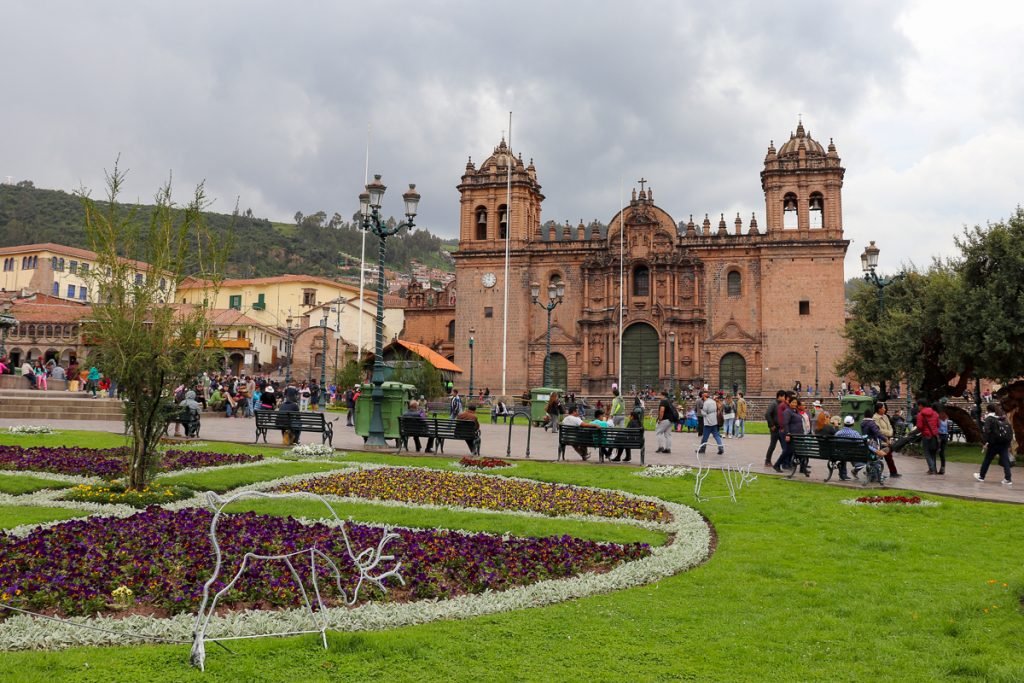
Two-Week Peru Itinerary: Touring the Sacred Valley
Not far from Cusco, the Sacred Valley of the Incas stretches between Pisac and Ollantaytambo. In Inca times, they built agricultural canals and terraces here—many still in use today.
On New Year’s Day, we hired a taxi to visit Pisac and Sacsayhuamán, two incredible archaeological sites. If you’re short on time, this Sacred Valley Tour is a great way to explore the region efficiently.
TRAVEL ADVICE
Investing in the general tourist ticket, commonly referred to as the “Boleto Turistico” proves to be a worthwhile decision for those planning to explore Cusco and the Sacred Valley.
Stop #1: Exploring Pisac
Famous for its pre-Columbian agricultural terraces, Pisac is one of the Sacred Valley’s true gems. Overlooking the town is a vast Inca complex, believed to have been both a citadel and a religious site. The local communities once cultivated crops on terraces and the floodplain—both still visible today.
We spent a couple of hours exploring this beautifully preserved site before heading to the town plaza market, a great spot for Andean crafts like knitted alpaca wool clothing and ceramics. The entrance to Pisac ruins is included in the Boleto Turístico.

Stop #2: Sacsayhuamán – A Must-See Inca Site
On the way back, we stopped at Sacsayhuamán, a 15th-century Inca citadel just outside Cusco, overlooking the city. Built as a fortress, it features massive dry stone walls, expertly fitted without mortar.
The citadel’s large square once hosted ceremonies, and several surrounding structures may have been used for rituals. The entrance to Sacsayhuamán is included in the Boleto Turístico.

Discover the best things to do in Cusco
POPULAR TOURS
Stop #3: Ollantaytambo – The Heart of the Sacred Valley
After Cusco, we moved to Ollantaytambo, a must-visit stop on any two-week Peru itinerary. This town, part of the Sacred Valley, is home to an impressive archaeological park where monumental Inca architecture meets advanced agricultural engineering. Ollantaytambo’s finely crafted stonework, terraces, fountains, and irrigation canals are still in use today.
The ruins are open from 7 AM to 5:30 PM, but they can get quite crowded. For a more peaceful visit, arrive early in the morning. Access to Ollantaytambo’s ruins is only available with the Boleto Turístico.
Find out more about the Boleto Turistico
Discover the best places to stay in Ollantaytambo
We recommend Quechua’s Lodge
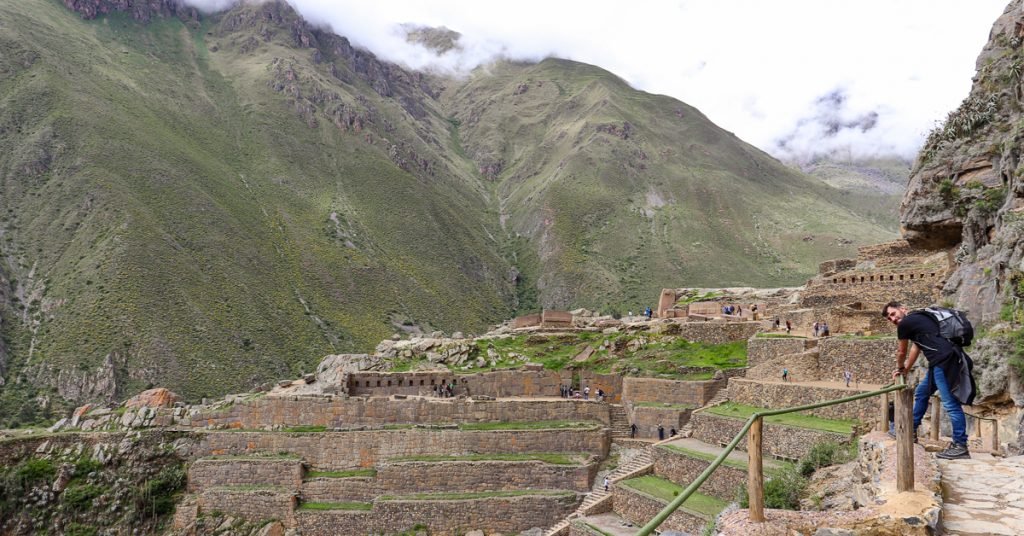
Stop #4: Moray & The Maras Salt Mines
Many travelers start their journey to Machu Picchu from Ollantaytambo. Adventurous souls trek the Inca Trail from here, passing lakes, agricultural communities, and stunning glacial landscapes. Unfortunately, we didn’t have time for the trail. However, we made sure to visit Moray and the Maras Salt Mines before heading to Machu Picchu, the final stop on our two-week Peru itinerary.
The Moray site features terraced circular depressions, sparking theories about its use for farming or ceremonies. The Maras Salt Mines consist of over 6,000 salt ponds, carved by the Wari civilization and operational for 500 years. Managed by Marasal S.A., local miners use ancient techniques, offering visitors an authentic experience. Look for the “Marasalt” label for genuine Peruvian salt!
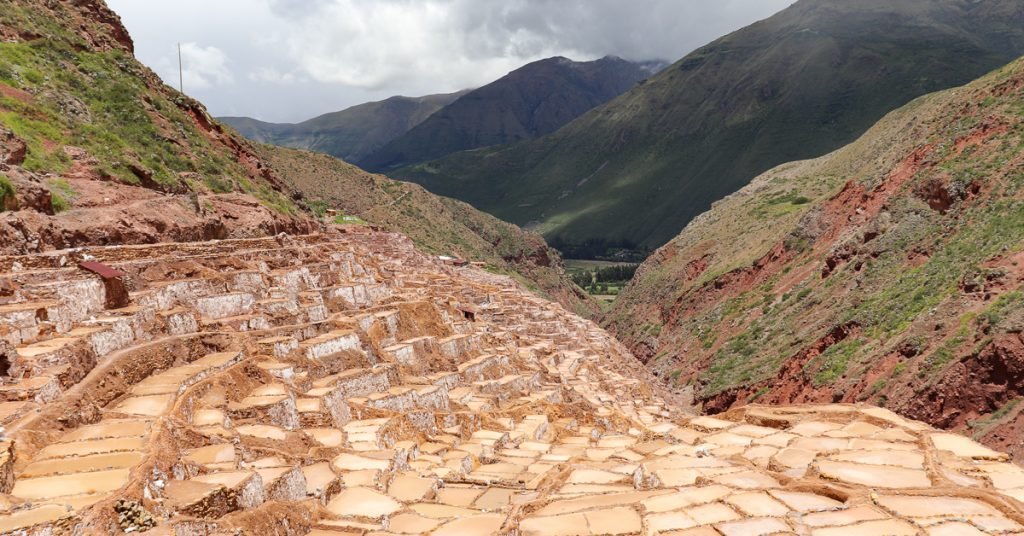

Stop #5: Machu Picchu – The Lost City of the Incas
Our two-week Peru itinerary wouldn’t be complete without a visit to Machu Picchu. As a UNESCO World Heritage Site and one of the New Seven Wonders of the World, it’s among the most visited archaeological sites globally. Daily entry is limited, and tickets sell out quickly. Additionally, train service to Machu Picchu is restricted. To ensure a smooth experience, plan your visit well in advance!
Self-Planning a Visit to Machu Picchu
To organize a visit to Machu Picchu on your own, start by securing a train ticket. The most common route is from Ollantaytambo to Aguas Calientes, the gateway to Machu Picchu. The train ride takes about 1.5 hours, showcasing stunning Andean landscapes. Unfortunately, train tickets can be expensive and sell out quickly. You can book your train ticket to Machu Picchu here.
Next, purchase your entrance ticket in advance to reserve your slot, available on the official website. Finally, make sure to book your accommodation in Aguas Calientes (Machu Picchu village). It’s wise to check both train and Machu Picchu tickets simultaneously when planning your visit!
Once in Aguas Calientes, you’ll need to take a bus to reach the Machu Picchu archaeological site. Buses run approximately every 10 minutes, with the journey taking 20 to 30 minutes. They can get crowded, so be prepared for some queues, especially in this popular destination.
Tickets are available at the ticket office located at Calle Mayta Cápac s/n, just steps from the bus station. The embarkation station is on Avenida Hermanos Ayar s/n, directly across from the Artisan market.
Machu Picchu Guided Tours
Self-planning a visit to Machu Picchu requires time and effort. To ensure everything runs smoothly, it’s important to stick to your planned schedule.
We recommend spending at least one night in Aguas Calientes if you plan to visit Machu Picchu on your own. From Ollantaytambo, we took a late afternoon train to Aguas Calientes, spent the night there, and visited Machu Picchu the following morning. This approach saved us a day, allowing us to explore Ollantaytambo, and it worked perfectly.
For a more relaxed experience with greater freedom, consider exploring the popular tours listed below!
Discover the best places to stay in Machu Picchu
We recommend Catari’s House
Visiting Machu Picchu
Upon entry, we hired a tour guide, which, while optional, is highly recommended for gaining insight into the site’s history. Although guided tours are no longer mandatory, they add value, especially for organized day trips.
Machu Picchu is a testament to Inca ingenuity, nestled in a stunning natural setting. Abandoned by locals and undiscovered by the Spanish, its remarkable preservation offers a glimpse into ancient Inca life.
Key sites include the Sun Gate, a control point for city access, and the Temple of the Sun, likely used for astronomical observations. For adventure seekers, climbing Huayna Picchu provides unique views, with its temples and terraces. Access requires advance booking, but the panoramic vistas are worth it!
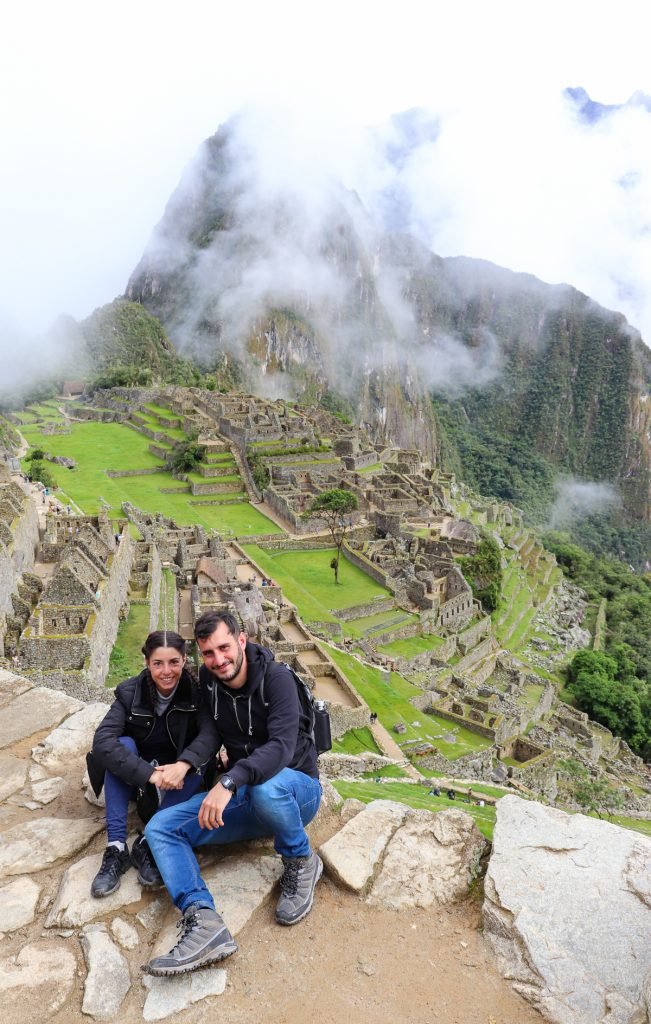
Time for Conclusions…
Visiting Peru was truly worthwhile and unforgettable. We loved exploring the spectacular Andean landscapes, discovering the mythical Inca ruins, and immersing ourselves in vibrant cultural traditions. Spending Christmas in the Amazon Rainforest was a once-in-a-lifetime experience, and we will always remember its wild beauty.
While we would have loved to add stops like Puno and Lake Titicaca, we realized it would have rushed our trip. We’re grateful for the experiences we had.
To recap, here’s our two-week Peru itinerary:
- Iquitos – Pacaya Samiria
- Lima
- Arequipa
- Cusco – Colca Canyon; Humantay Lagoon; Pisac; Sacsayhuaman
- Ollantaytambo – Moray; Maras Salt Mines
- Machu Picchu
- Lima
Don’t forget to read also our article on the Peruvian Amazon Rainforest
You can find all our blog posts in ‘our trips’
See you soon!
Peace of mind is just one click away.
Get insured now

Pingback: Peruvian Amazon Rainforest Tour - Next Trip...Loading